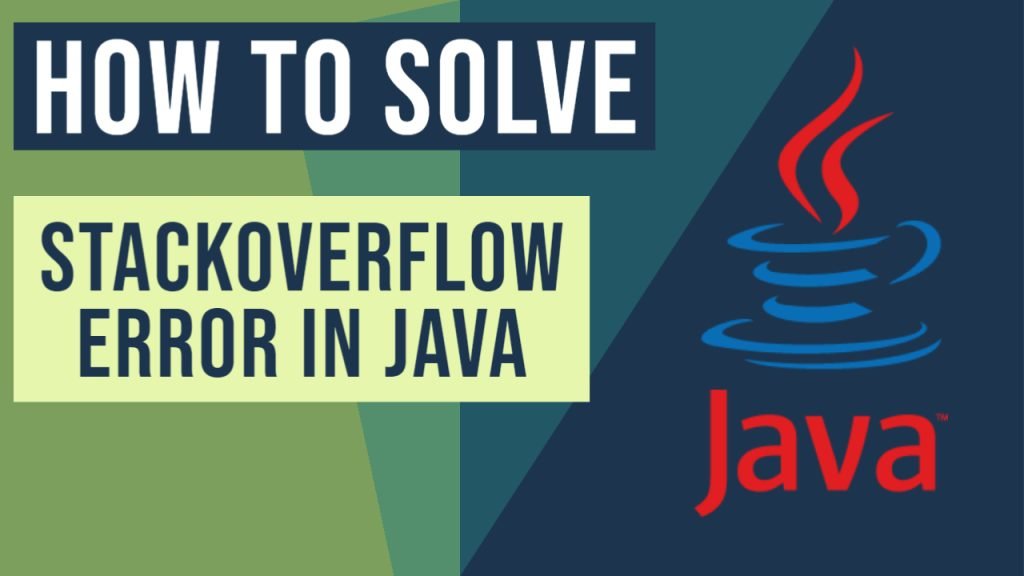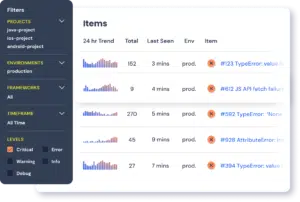The java.lang.StackOverflowError is a runtime error which points to serious problems that cannot be caught by an application. The java.lang.StackOverflowError indicates that the application stack is exhausted and is usually caused by deep or infinite recursion.
What Causes java.lang.StackOverflowError in Java
The java.lang.StackOverflowError occurs when the application stack continues to grow until it reaches the maximum limit. Some of the most common causes for a java.lang.StackOverflowError are:
- Deep or infinite recursion — If a method calls itself recursively without a terminating condition.
- Cyclic relationships between classes — If a class
Ainstantiates an object of classB, which in turn instantiates an object of classA. This can be considered as a form of recursion. - Memory intensive applications — Applications that rely on resource heavy objects such as XML documents, GUI or java2D classes.
java.lang.StackOverflowError Example in Java
Here is an example of java.lang.StackOverflowError thrown due to unintended recursion:
public class StackOverflowErrorExample {
public void print(int myInt) {
System.out.println(myInt);
print(myInt);
}
public static void main(String[] args) {
StackOverflowErrorExample soee = new StackOverflowErrorExample();
soee.print(0);
}
}
In this example, the recursive method print() calls itself over and over again until it reaches the maximum size of the Java thread stack since a terminating condition is not provided for the recursive calls. When the maximum size of the stack is reached, the program exits with a java.lang.StackOverflowError:
Exception in thread "main" java.lang.StackOverflowError
at java.base/sun.nio.cs.UTF_8$Encoder.encodeLoop(UTF_8.java:564)
at java.base/java.nio.charset.CharsetEncoder.encode(CharsetEncoder.java:585)
at java.base/sun.nio.cs.StreamEncoder.implWrite(StreamEncoder.java:301)
at java.base/sun.nio.cs.StreamEncoder.implWrite(StreamEncoder.java:290)
at java.base/sun.nio.cs.StreamEncoder.write(StreamEncoder.java:131)
at java.base/java.io.OutputStreamWriter.write(OutputStreamWriter.java:208)
at java.base/java.io.BufferedWriter.flushBuffer(BufferedWriter.java:120)
at java.base/java.io.PrintStream.writeln(PrintStream.java:722)
at java.base/java.io.PrintStream.println(PrintStream.java:938)
at StackOverflowErrorExample.print(StackOverflowErrorExample.java:3)
at StackOverflowErrorExample.print(StackOverflowErrorExample.java:4)
at StackOverflowErrorExample.print(StackOverflowErrorExample.java:4)
at StackOverflowErrorExample.print(StackOverflowErrorExample.java:4)
at StackOverflowErrorExample.print(StackOverflowErrorExample.java:4)
How to fix java.lang.StackOverflowError in Java
Inspect the stack trace
Carefully inspecting the error stack trace and looking for the repeating pattern of line numbers enables locating the line of code with the recursive calls. When the line is identified, the code should be examined and fixed by specifying a proper terminating condition. As an example, the error stack trace seen earlier can be inspected:
at java.base/java.io.PrintStream.writeln(PrintStream.java:722)
at java.base/java.io.PrintStream.println(PrintStream.java:938)
at StackOverflowErrorExample.print(StackOverflowErrorExample.java:3)
at StackOverflowErrorExample.print(StackOverflowErrorExample.java:4)
at StackOverflowErrorExample.print(StackOverflowErrorExample.java:4)
at StackOverflowErrorExample.print(StackOverflowErrorExample.java:4)
at StackOverflowErrorExample.print(StackOverflowErrorExample.java:4)In the above trace, line number 4 can be seen repeating, which is where the recursive calls are made and causing java.lang.StackOverflowError.
Increase Thread Stack Size (-Xss)
If the code has been updated to implement correct recursion and the program still throws a java.lang.StackOverflowError, the thread stack size can be increased to allow a larger number of invocations. Increasing the stack size can be useful, for example, when the program involves calling a large number of methods or using lots of local variables.
The stack size can be increased by changing the -Xss argument on the JVM, which can be set when starting the application. Here is an example:
-Xss4mThis will set the thread’s stack size to 4 mb which should prevent the JVM from throwing a java.lang.StackOverflowError.
Track, Analyze and Manage Errors With Rollbar
Managing errors and exceptions in your code is challenging. It can make deploying production code an unnerving experience. Being able to track, analyze, and manage errors in real-time can help you to proceed with more confidence. Rollbar automates Java error monitoring and triaging, making fixing errors easier than ever. Try it today.
This is a typical case of java.lang.StackOverflowError… The method is recursively calling itself with no exit in doubleValue(), floatValue(), etc.
File Rational.java
public class Rational extends Number implements Comparable<Rational> {
private int num;
private int denom;
public Rational(int num, int denom) {
this.num = num;
this.denom = denom;
}
public int compareTo(Rational r) {
if ((num / denom) - (r.num / r.denom) > 0) {
return +1;
} else if ((num / denom) - (r.num / r.denom) < 0) {
return -1;
}
return 0;
}
public Rational add(Rational r) {
return new Rational(num + r.num, denom + r.denom);
}
public Rational sub(Rational r) {
return new Rational(num - r.num, denom - r.denom);
}
public Rational mul(Rational r) {
return new Rational(num * r.num, denom * r.denom);
}
public Rational div(Rational r) {
return new Rational(num * r.denom, denom * r.num);
}
public int gcd(Rational r) {
int i = 1;
while (i != 0) {
i = denom % r.denom;
denom = r.denom;
r.denom = i;
}
return denom;
}
public String toString() {
String a = num + "/" + denom;
return a;
}
public double doubleValue() {
return (double) doubleValue();
}
public float floatValue() {
return (float) floatValue();
}
public int intValue() {
return (int) intValue();
}
public long longValue() {
return (long) longValue();
}
}
File Main.java
public class Main {
public static void main(String[] args) {
Rational a = new Rational(2, 4);
Rational b = new Rational(2, 6);
System.out.println(a + " + " + b + " = " + a.add(b));
System.out.println(a + " - " + b + " = " + a.sub(b));
System.out.println(a + " * " + b + " = " + a.mul(b));
System.out.println(a + " / " + b + " = " + a.div(b));
Rational[] arr = {new Rational(7, 1), new Rational(6, 1),
new Rational(5, 1), new Rational(4, 1),
new Rational(3, 1), new Rational(2, 1),
new Rational(1, 1), new Rational(1, 2),
new Rational(1, 3), new Rational(1, 4),
new Rational(1, 5), new Rational(1, 6),
new Rational(1, 7), new Rational(1, 8),
new Rational(1, 9), new Rational(0, 1)};
selectSort(arr);
for (int i = 0; i < arr.length - 1; ++i) {
if (arr[i].compareTo(arr[i + 1]) > 0) {
System.exit(1);
}
}
Number n = new Rational(3, 2);
System.out.println(n.doubleValue());
System.out.println(n.floatValue());
System.out.println(n.intValue());
System.out.println(n.longValue());
}
public static <T extends Comparable<? super T>> void selectSort(T[] array) {
T temp;
int mini;
for (int i = 0; i < array.length - 1; ++i) {
mini = i;
for (int j = i + 1; j < array.length; ++j) {
if (array[j].compareTo(array[mini]) < 0) {
mini = j;
}
}
if (i != mini) {
temp = array[i];
array[i] = array[mini];
array[mini] = temp;
}
}
}
}
Result
2/4 + 2/6 = 4/10
Exception in thread "main" java.lang.StackOverflowError
2/4 - 2/6 = 0/-2
at com.xetrasu.Rational.doubleValue(Rational.java:64)
2/4 * 2/6 = 4/24
at com.xetrasu.Rational.doubleValue(Rational.java:64)
2/4 / 2/6 = 12/8
at com.xetrasu.Rational.doubleValue(Rational.java:64)
at com.xetrasu.Rational.doubleValue(Rational.java:64)
at com.xetrasu.Rational.doubleValue(Rational.java:64)
at com.xetrasu.Rational.doubleValue(Rational.java:64)
at com.xetrasu.Rational.doubleValue(Rational.java:64)
Here is the source code of StackOverflowError in OpenJDK 7.
Автор оригинала: baeldung.
1. Обзор
StackOverflowError может раздражать разработчиков Java, так как это одна из самых распространенных ошибок во время выполнения, с которой мы можем столкнуться.
В этой статье мы рассмотрим, как может возникнуть эта ошибка, рассмотрев различные примеры кода, а также то, как мы можем с ней справиться.
Давайте начнем с основ. При вызове метода в стеке вызовов создается новый кадр стека. Этот кадр стека содержит параметры вызываемого метода, его локальные переменные и адрес возврата метода, т. е. точку, из которой выполнение метода должно продолжаться после возврата вызванного метода.
Создание фреймов стека будет продолжаться до тех пор, пока не будет достигнут конец вызовов методов, найденных внутри вложенных методов.
Во время этого процесса, если JVM столкнется с ситуацией, когда нет места для создания нового кадра стека, он выдаст StackOverflowError .
Наиболее распространенной причиной, по которой JVM сталкивается с этой ситуацией, является unterminated/бесконечная рекурсия – в описании Javadoc для StackOverflowError упоминается, что ошибка возникает в результате слишком глубокой рекурсии в конкретном фрагменте кода.
Однако рекурсия-не единственная причина этой ошибки. Это также может произойти в ситуации, когда приложение продолжает вызывать методы из методов до тех пор, пока стек не будет исчерпан . Это редкий случай, поскольку ни один разработчик не будет намеренно следовать плохим методам кодирования. Другой редкой причиной является наличие огромного количества локальных переменных внутри метода .
Ошибка StackOverflowError также может быть вызвана, когда приложение предназначено для циклических отношений c между классами . В этой ситуации конструкторы друг друга вызываются повторно, что приводит к возникновению этой ошибки. Это также можно рассматривать как форму рекурсии.
Другой интересный сценарий, который вызывает эту ошибку, заключается в том, что экземпляр класса создается в том же классе, что и переменная экземпляра этого класса . Это приведет к тому, что конструктор одного и того же класса будет вызываться снова и снова (рекурсивно), что в конечном итоге приведет к ошибке StackOverflowError.
В следующем разделе мы рассмотрим некоторые примеры кода, демонстрирующие эти сценарии.
3. Ошибка StackOverflowError в действии
В примере, показанном ниже, StackOverflowError будет вызван из-за непреднамеренной рекурсии, когда разработчик забыл указать условие завершения для рекурсивного поведения:
public class UnintendedInfiniteRecursion {
public int calculateFactorial(int number) {
return number * calculateFactorial(number - 1);
}
}
Здесь ошибка возникает во всех случаях для любого значения, переданного в метод:
public class UnintendedInfiniteRecursionManualTest {
@Test(expected = StackOverflowError.class)
public void givenPositiveIntNoOne_whenCalFact_thenThrowsException() {
int numToCalcFactorial= 1;
UnintendedInfiniteRecursion uir
= new UnintendedInfiniteRecursion();
uir.calculateFactorial(numToCalcFactorial);
}
@Test(expected = StackOverflowError.class)
public void givenPositiveIntGtOne_whenCalcFact_thenThrowsException() {
int numToCalcFactorial= 2;
UnintendedInfiniteRecursion uir
= new UnintendedInfiniteRecursion();
uir.calculateFactorial(numToCalcFactorial);
}
@Test(expected = StackOverflowError.class)
public void givenNegativeInt_whenCalcFact_thenThrowsException() {
int numToCalcFactorial= -1;
UnintendedInfiniteRecursion uir
= new UnintendedInfiniteRecursion();
uir.calculateFactorial(numToCalcFactorial);
}
}
Однако в следующем примере указано условие завершения, но оно никогда не выполняется, если значение -1 передается в метод calculateFactorial () , который вызывает нескончаемую/бесконечную рекурсию:
public class InfiniteRecursionWithTerminationCondition {
public int calculateFactorial(int number) {
return number == 1 ? 1 : number * calculateFactorial(number - 1);
}
}
Этот набор тестов демонстрирует этот сценарий:
public class InfiniteRecursionWithTerminationConditionManualTest {
@Test
public void givenPositiveIntNoOne_whenCalcFact_thenCorrectlyCalc() {
int numToCalcFactorial = 1;
InfiniteRecursionWithTerminationCondition irtc
= new InfiniteRecursionWithTerminationCondition();
assertEquals(1, irtc.calculateFactorial(numToCalcFactorial));
}
@Test
public void givenPositiveIntGtOne_whenCalcFact_thenCorrectlyCalc() {
int numToCalcFactorial = 5;
InfiniteRecursionWithTerminationCondition irtc
= new InfiniteRecursionWithTerminationCondition();
assertEquals(120, irtc.calculateFactorial(numToCalcFactorial));
}
@Test(expected = StackOverflowError.class)
public void givenNegativeInt_whenCalcFact_thenThrowsException() {
int numToCalcFactorial = -1;
InfiniteRecursionWithTerminationCondition irtc
= new InfiniteRecursionWithTerminationCondition();
irtc.calculateFactorial(numToCalcFactorial);
}
}
В данном конкретном случае ошибки можно было бы полностью избежать, если бы условие завершения было просто сформулировано как:
public class RecursionWithCorrectTerminationCondition {
public int calculateFactorial(int number) {
return number <= 1 ? 1 : number * calculateFactorial(number - 1);
}
}
Вот тест, который показывает этот сценарий на практике:
public class RecursionWithCorrectTerminationConditionManualTest {
@Test
public void givenNegativeInt_whenCalcFact_thenCorrectlyCalc() {
int numToCalcFactorial = -1;
RecursionWithCorrectTerminationCondition rctc
= new RecursionWithCorrectTerminationCondition();
assertEquals(1, rctc.calculateFactorial(numToCalcFactorial));
}
}
Теперь давайте рассмотрим сценарий, в котором StackOverflowError возникает в результате циклических отношений между классами. Давайте рассмотрим ClassOne и classstwo , которые создают экземпляры друг друга внутри своих конструкторов, вызывая циклическую связь:
public class ClassOne {
private int oneValue;
private ClassTwo clsTwoInstance = null;
public ClassOne() {
oneValue = 0;
clsTwoInstance = new ClassTwo();
}
public ClassOne(int oneValue, ClassTwo clsTwoInstance) {
this.oneValue = oneValue;
this.clsTwoInstance = clsTwoInstance;
}
}
public class ClassTwo {
private int twoValue;
private ClassOne clsOneInstance = null;
public ClassTwo() {
twoValue = 10;
clsOneInstance = new ClassOne();
}
public ClassTwo(int twoValue, ClassOne clsOneInstance) {
this.twoValue = twoValue;
this.clsOneInstance = clsOneInstance;
}
}
Теперь предположим, что мы попытаемся создать экземпляр Class One , как показано в этом тесте:
public class CyclicDependancyManualTest {
@Test(expected = StackOverflowError.class)
public void whenInstanciatingClassOne_thenThrowsException() {
ClassOne obj = new ClassOne();
}
}
Это заканчивается StackOverflowError , так как конструктор Class One создает экземпляр Class Two, и конструктор classwo снова создает экземпляр ClassOne. И это повторяется до тех пор, пока он не переполнит стек.
Далее мы рассмотрим, что происходит, когда экземпляр класса создается в том же классе, что и переменная экземпляра этого класса.
Как видно из следующего примера, Владелец счета создает экземпляр в качестве переменной экземпляра Владелец совместного счета :
public class AccountHolder {
private String firstName;
private String lastName;
AccountHolder jointAccountHolder = new AccountHolder();
}
Когда Владелец учетной записи класс создается , a StackOverflowError выбрасывается из-за рекурсивного вызова конструктора, как показано в этом тесте:
public class AccountHolderManualTest {
@Test(expected = StackOverflowError.class)
public void whenInstanciatingAccountHolder_thenThrowsException() {
AccountHolder holder = new AccountHolder();
}
}
4. Работа С Ошибкой StackOverflowError
Лучшее, что можно сделать при обнаружении StackOverflowError , – это осторожно проверить трассировку стека, чтобы определить повторяющийся шаблон номеров строк. Это позволит нам найти код, который имеет проблемную рекурсию.
Лучшее, что можно сделать при обнаружении || StackOverflowError||, – это осторожно проверить трассировку стека, чтобы определить повторяющийся шаблон номеров строк. Это позволит нам найти код, который имеет проблемную рекурсию.
Эта трассировка стека создается Бесконечной рекурсией С ручным тестом условия завершения , если мы опустим объявление ожидаемого исключения:
java.lang.StackOverflowError at c.b.s.InfiniteRecursionWithTerminationCondition .calculateFactorial(InfiniteRecursionWithTerminationCondition.java:5) at c.b.s.InfiniteRecursionWithTerminationCondition .calculateFactorial(InfiniteRecursionWithTerminationCondition.java:5) at c.b.s.InfiniteRecursionWithTerminationCondition .calculateFactorial(InfiniteRecursionWithTerminationCondition.java:5) at c.b.s.InfiniteRecursionWithTerminationCondition .calculateFactorial(InfiniteRecursionWithTerminationCondition.java:5)
Здесь можно увидеть повторение строки № 5. Именно здесь выполняется рекурсивный вызов. Теперь это просто вопрос изучения кода, чтобы увидеть, правильно ли выполняется рекурсия.
Вот трассировка стека, которую мы получаем, выполняя ручной тест циклической зависимости (опять же, без ожидаемого исключения):
java.lang.StackOverflowError at c.b.s.ClassTwo.(ClassTwo.java:9) at c.b.s.ClassOne.(ClassOne.java:9) at c.b.s.ClassTwo.(ClassTwo.java:9) at c.b.s.ClassOne.(ClassOne.java:9)
Эта трассировка стека показывает номера строк, которые вызывают проблему в двух классах, находящихся в циклической связи. Строка номер 9 класса Два и строка номер 9 класса Один указывают на местоположение внутри конструктора, где он пытается создать экземпляр другого класса.
После тщательной проверки кода и если ни одно из следующих действий (или любая другая логическая ошибка кода) не является причиной ошибки:
- Неправильно реализованная рекурсия (т. е. без условия завершения)
- Циклическая зависимость между классами
- Создание экземпляра класса в том же классе, что и переменная экземпляра этого класса
Было бы неплохо попытаться увеличить размер стека. В зависимости от установленной JVM размер стека по умолчанию может варьироваться.
Флаг -Xss можно использовать для увеличения размера стека либо из конфигурации проекта, либо из командной строки.
5. Заключение
В этой статье мы более подробно рассмотрели StackOverflowError , включая то, как Java-код может вызвать его, а также как мы можем диагностировать и исправить его.
Исходный код, связанный с этой статьей, можно найти на GitHub .
The java.lang.stackoverflowerror – StackOverflow Error in Java is thrown to indicate that the application’s stack was exhausted, due to deep recursion.
The StackOverflowError extends the VirtualMachineError class, which indicates that the JVM is broken, or it has run out of resources and cannot operate. Furthermore, the VirtualMachineError extends the Error class, which is used to indicate those serious problems that an application should not catch. A method may not declare such errors in its throw clause, because these errors are abnormal conditions that shall never occur.
Finally, the StackOverflowError exists since the 1.0 version of Java.
You can also check this tutorial in the following video:

1. The Structure of StackOverflowError
Constructors
StackOverflowError()
Creates an instance of the StackOverflowError class, setting null as its message.
StackOverflowError(String s)
Creates an instance of the StackOverflowError class, using the specified string as message. The string argument indicates the name of the class that threw the error.
2. The StackOverflowError in Java
When a function call is invoked by a Java application, a stack frame is allocated on the call stack. The stack frame contains the parameters of the invoked method, its local parameters, and the return address of the method. The return address denotes the execution point from which, the program execution shall continue after the invoked method returns. If there is no space for a new stack frame then, the StackOverflowError is thrown by the Java Virtual Machine (JVM).

The most common case that can possibly exhaust a Java application’s stack is recursion. In recursion, a method invokes itself during its execution. Recursion is considered as a powerful general-purpose programming technique, but must be used with caution, in order for the StackOverflowError to be avoided.
An example that throws a StackOverflowError is shown below:
StackOverflowErrorExample.java
|
01 02 03 04 05 06 07 08 09 10 11 12 13 14 15 |
|
In this example, we define a recursive method, called recursivePrint that prints an integer and then, calls itself, with the next successive integer as an argument. The recursion ends once we invoke the method, passing 0 as a parameter. However, in our example, we start printing numbers from 1 and thus, the recursion will never terminate.
A sample execution, using the -Xss1M flag that specifies the size of the thread stack to equal to 1MB, is shown below:
|
01 02 03 04 05 06 07 08 09 10 11 12 13 14 15 16 17 18 19 20 21 22 23 |
|
Depending on the JVM’s initial configuration, the results may differ, but eventually the StackOverflowError shall be thrown. This example is a very good example of how recursion can cause problems, if not implemented with caution.
3. More about the java.lang.stackoverflowerror
The following example demonstrates the risk of having cyclic relationships between classes:
StackOverflowErrorToStringExample.java:
|
01 02 03 04 05 06 07 08 09 10 11 12 13 14 15 16 17 18 19 20 21 22 23 24 25 26 27 28 29 30 31 32 33 34 35 36 |
|
In this example, we defined two classes, A and B. The class A contains one instance of the B class, while, the B class contains one instance of the A class. Thus, we have a circular dependency between these two classes. Furthermore, each toString method, invokes the corresponding toString method of the other class, and so on, which results in a StackOverflowError.
A sample execution is shown below:
|
1 2 3 4 5 6 7 8 |
|
4. How to deal with the java.lang.stackoverflowerror
- The simplest solution is to carefully inspect the stack trace and detect the repeating pattern of line numbers. These line numbers indicate the code being recursively called. Once you detect these lines, you must carefully inspect your code and understand why the recursion never terminates.
- If you have verified that the recursion is implemented correctly, you can increase the stack’s size, in order to allow a larger number of invocations. Depending on the Java Virtual Machine (JVM) installed, the default thread stack size may equal to either
512KB, or1MB. You can increase the thread stack size using the-Xssflag. This flag can be specified either via the project’s configuration, or via the command line. The format of the-Xssargument is:-Xss<size>[g|G|m|M|k|K]
5. Additional knowledge
- STACKOVERFLOWERROR: CAUSES & SOLUTIONS
- java.lang.ClassNotFoundException – How to solve Class Not Found Exception
- Unreachable Statement Java Error – How to resolve it
- java.lang.NullPointerException Example – How to handle Java Null Pointer Exception (with video)
- Try Catch Java Example
- Java Stack Example (with video)
- Online Java Compiler – What options are there
- What is null in Java
6. Download the Eclipse Project
This was a tutorial about the StackOverflowError in Java.
Last updated on Oct. 12th, 2021

Sotirios-Efstathios (Stathis) Maneas is a PhD student at the Department of Computer Science at the University of Toronto. His main interests include distributed systems, storage systems, file systems, and operating systems.
StackOverFlowError is one of the common confronted JVM error. In this blog post, lets learn inner mechanics of thread stacks, reasons that can trigger StackOverFlowError and potential solutions to address this error.
To gain deeper understanding into StackOverFlowError, let’s review this simple program:
public class SimpleExample {
public static void main(String args[]) {
a()
}
public static void a() {
int x = 0;
b();
}
public static void b() {
Car y = new Car();
c();
}
public static void c() {
float z = 0f;
System.out.println("Hello");
}
}
This program is very simple with the following execution code:
- main() method is invoked first
- main() method invokes a() method. Inside a() method integer variable ‘x’ is initialized to value 0.
- a() method in turn invokes b() method. Inside b() method Car object is constructed and assigned to variable ‘y’.
- b() method in turn invokes c() method. Inside c() method float variable ‘z’ is initialized to value 0.
Now let’s review what happens behind the scenes when above simple program is executed. Each thread in the application has its own stack. Each stack has multiple stack frames. Thread adds the methods it’s executing, primitive data types, object pointers, return values to its stack frame in the sequence order in which they are executed.
Fig 1: Thread’s Stack frame
In step #1: main() method is pushed into the application thread’s stack.
In step #2: a() method is pushed into application thread’s stack. In a() method, primitive data type ‘int’ is defined with value 0 and assigned to variable x. This information is also pushed into the same stack frame. Note both data i.e. ‘0’ and variable ‘x’ is pushed into thread’s stack frame.
In step #3: b() method is pushed into thread’s stack. In b() method, ‘Car’ object is created and assigned to variable ‘y’. Crucial point to note here is ‘Car’ object is created in the heap and not in the thread’s stack. Only Car object’s reference i.e. y is stored in the thread’s stack frame.
In step #4: c() method is pushed into thread’s stack. In c() method, primitive data type ‘float’ is defined with value 0f and assigned to variable z. This information is also pushed into same stack frame. Note both data i.e. ‘0f’ and variable ‘z’ is pushed into thread’s stack frame.
Once each method’s execution is completed, then method and the variables/object pointers which are stored in the stack frame are removed as shown in Fig 2.
Fig 2: Thread’s stack frame after executing methods
As you can see thread’s stack is storing methods it’s executing, primitive datatypes, variables, object pointers, and return values. All of these consume memory. If thread’s stack sizes grow beyond the allocated memory limit then StackOverflowError is thrown. Let’s look at the below buggy program, which will result in StackOverflowError:
public class SOFDemo {
public static void a() {
// Buggy line. It will cause method a() to be called infinite number of times.
a();
}
public static void main(String args[]) {
a();
}
}
In this program main() method invokes a() method. a() method recursively calls itself. This implementation will cause a() method to be invoked infinite number of times. In this circumstance a() method will be added to thread’s stack frame infinite number of times. Thus, after a few thousand iterations thread’s stack size limit would be exceeded. Once stack size limit is exceeded it will result in ‘StackOverflowError’:
Exception in thread "main" java.lang.StackOverflowError
at com.buggyapp.stackoverflow.SOFDemo.a(SOFDemo.java:7)
at com.buggyapp.stackoverflow.SOFDemo.a(SOFDemo.java:7)
at com.buggyapp.stackoverflow.SOFDemo.a(SOFDemo.java:7)
at com.buggyapp.stackoverflow.SOFDemo.a(SOFDemo.java:7)
at com.buggyapp.stackoverflow.SOFDemo.a(SOFDemo.java:7)
at com.buggyapp.stackoverflow.SOFDemo.a(SOFDemo.java:7)
at com.buggyapp.stackoverflow.SOFDemo.a(SOFDemo.java:7)
at com.buggyapp.stackoverflow.SOFDemo.a(SOFDemo.java:7)
Fig 3: StackOverflowError progression
What are the solutions to StackOverflowError?
There are couple of strategies to address StackOverflowError.
1. Fix the code
Because of a non-terminating recursive call (as shown in the above example), threads stack size can grow to a large size. In those circumstance, you must fix the source code which is causing recursive looping. When ‘StackOverflowError’ is thrown, it will print the stacktrace of the code that it was recursively executing. This code is a good pointer to start debugging and fixing the issue. In the above example it’s ‘a()’ method.
2. Increase Thread Stack Size (-Xss)
There might be legitimate reason where a threads stack size needs to be increased. Maybe thread has to execute large number of methods or lot of local variables/created in the methods thread has been executing. In such circumstance, you can increase the thread’s stack size using the JVM argument: ‘-Xss’. This argument needs to be passed when you start the application. Example:
-Xss2m
This will set the thread’s stack size to 2 mb.
It might bring a question, what is the default thread’s stack size? Default thread stack size varies based on your operating system, java version & vendor.
| JVM version | Thread stack size |
| Sparc 32-bit JVM | 512k |
| Sparc 64-bit JVM | 1024k |
| x86 Solaris/Linux 32-bit JVM | 320K |
| x86 Solaris/Linux 64-bit JVM | 1024K |
| Windows 32-bit JVM | 320K |
| Windows 64-bit JVM | 1024K |
Additional Reference
java.lang.StackOverflowError – How to solve StackOverflowError




